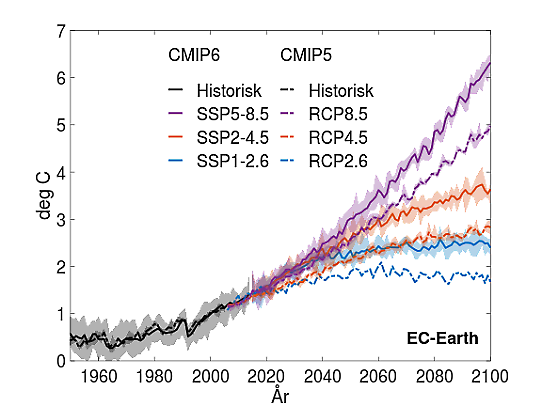Years of collaboration between researchers at SMHI’s Rossby Centre and international partners in the EC-Earth consortium have resulted in a new version of the EC-Earth climate model, launched December 2018. Since then the Rossby Centre has carried out an extensive amount of calculations to investigate how the climate may change in the future. These calculations are part of the CMIP6 intercomparison project bringing together around fifty different climate models worldwide. The future simulations are based on the new CMIP6 scenarios, which have been developed based on the newest and most updated assumptions of future socioeconomic development and related greenhouse gas concentrations, and represent the best state of knowledge at this time.
Simulations showed stronger warming
First results from Rossby Centre’s simulations with the newest version of EC-Earth showed stronger warming compared to the results from the previous intercomparison project (CMIP5) where the previous version of EC-Earth was used. Similar results were found for a number of other CMIP6 models. “These results were received with some apprehension since a stronger warming would have severe implications”, says Klaus Wyser, researcher at the Rossby Centre. “It implies that the remaining carbon budgets to limit global warming to 2⁰C above pre-industrial conditions have to be revised downwards making it even more difficult to fulfil the Paris Agreement. It also means that the warming for any amount of emitted greenhouse gases will be stronger and lead to more significant impacts earlier than previously considered.”

According to Helena Martins, research communicator at the Rossby Centre, “these results can have huge policy implications since planned measures for climate change adaptation may not be sufficient and there might be a need to strengthen existing emissions reductions targets”.
Two explanations to the stronger warming
Similar to other CMIP6 models, the new version of EC-Earth shows higher climate sensitivity compared to the CMIP5 version. Simply put, climate sensitivity expresses how much temperature changes with increased levels of CO2 concentrations. In EC-Earth the increase in climate sensitivity can be attributed to the more advanced treatment of aerosols, with the largest contribution coming from the effect of aerosols on cloud microphysics.
However, the increased sensitivity is not the only cause for the stronger warming in the new CMIP6 future scenarios a new study by Klaus Wyser and colleagues from the Rossby Centre published in Environmental Research Letters reveals.
“In our study, we identify changes in greenhouse gas concentrations from CMIP5 to CMIP6 as a major contributor to the larger warming until the end of the century; these explain around 50% of the extra warming in EC-Earth results”, explains Klaus. Asked about if the same holds for other models, he believes “it might hold for other models, and therefore we encourage other groups to make similar experiments. A better understanding of the effect on climate change from the differences between CMIP5 and CMIP6 forcings across more CMIP6 models is necessary so that potential future climate change, associated uncertainties and impacts can be communicated in a credible way.”
Aware of the additional challenge posed by a potential sharpening of the message around new future projections, Helena concludes that “the new climate projections, coming from EC-Earth and other CMIP6 models, constitute a crucial new piece of information on future climate change and should be used in combination with other pieces of information, including previous modelling studies such as CMIP5 and studies looking at emergent constraints, to develop sound mitigation and adaptation strategies encompassing the full range of possible futures.”
The first step towards a complete climate service
The climate calculations will continue to be analysed by researchers at the Rossby Centre, comparing them with calculations from other research teams who are carrying out equivalent climate calculations within the CMIP6 international collaboration. In the future, it will be possible to interpret these climate calculations using a regional climate model, giving more detailed data about climate change in Sweden.
“Once the regional processing is complete, we will have sufficiently detailed data to present a climate service that can be used when making societal adaptations in line with a changed climate, for example,” adds Ralf Döscher, head of the Rossby Centre, when they presented the new simulations last autumn. “In the meantime, it is best to continue using the data published via our climate services at smhi.se.”